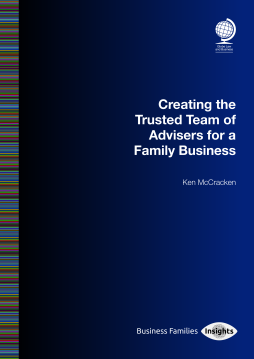
Additional Information
Book Details
Abstract
The idea that every family business needs a trusted adviser is a popular one. This adviser is often portrayed as an individual who has a close personal relationship with the family and who coordinates the advice that they receive from a range of specialists. However, this model of a single adviser is not always the most effective when trying to build sustainable trust relationships alongside the generational changes that inevitably occur in family businesses.
In an era where every adviser is a specialist, it is necessary to explore an alternative to the individual trusted adviser. This special report describes how family businesses can benefit from a high-performing, inter-disciplinary advisory team for trusted advice, with members sourced from different organisations, and who have demonstrably effective processes for looking after an entire family and their business interests. Members of such a team are committed to helping the family achieve success in terms of both family and business life and, like a true team, this success is dependent on all team members.
High performance advisory teams are used in many areas of commerce, sport, science and the arts and this book demonstrates how the same can be true for advisers who serve family businesses, regardless of their specialism.
Table of Contents
| Section Title | Page | Action | Price |
|---|---|---|---|
| Front cover | i | ||
| Title | 1 | ||
| Copyright | 2 | ||
| Table of contents | 3 | ||
| Introduction | 7 | ||
| We need to talk about specialists | 13 | ||
| 1. The sedative effect of specialist advice | 14 | ||
| 2. The ambidextrous, T-shaped gatekeeper | 19 | ||
| 3. Moving forwards by looking backwards | 20 | ||
| Do not trust best practice | 23 | ||
| 1. What is best, and worst? | 23 | ||
| 2. The best practice fallacy | 25 | ||
| 3. The risk of doing damage | 27 | ||
| 4. Conventional wisdom | 28 | ||
| 5. An alternative approach | 31 | ||
| Soft skills are not enough | 33 | ||
| 1. Emotional intelligence | 33 | ||
| 2. Economic necessity | 35 | ||
| 3. Competency and the effect of regulation | 36 | ||
| 4. Trust in organisations | 39 | ||
| 5. Marketing trust | 40 | ||
| Who do you trust? | 43 | ||
| 1. The in-group attitude | 43 | ||
| 2. Limitations of the in-group attitude | 45 | ||
| 3. The optimists | 46 | ||
| 4. How attitudes affect relationships | 47 | ||
| Trusting a shared purpose | 51 | ||
| 1. The risk of assumptions | 51 | ||
| 2. Working with a shared purpose | 54 | ||
| 3. Who is the client? | 61 | ||
| 4. What if there is no shared purpose? (The cult of continuity) | 65 | ||
| Creating the trusted team | 69 | ||
| 1. What type of team? | 70 | ||
| 2. Creating an advisory team | 72 | ||
| 3. The shared purpose | 73 | ||
| 4. Appointment | 73 | ||
| 5. Accountability | 78 | ||
| 6. Reward | 80 | ||
| 7. Leadership | 83 | ||
| 8. Family advisers’ constitution | 83 | ||
| 9. Do advisers want to work as a team? | 85 | ||
| About the author | 88 | ||
| Back cover | 90 |
